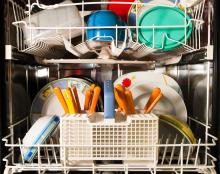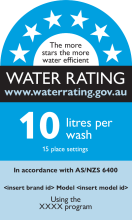
10% of household water consumption is used for cooking, cleaning, washing or drinking in the kitchen.
- Wash your vegetables in a container, not under running water.
- When boiling vegetables, use just enough water to cover them and keep the lid on the saucepan. Your vegetables will boil quicker and maintain precious vitamins in the food.
- Don’t rinse dishes under a running tap. If you have two sinks, fill the second one with rinsing water. If you have only one sink, stack washed dishes in a dish rack and rinse them with a pan of hot water
- Garbage-disposal units use about 6 litres of water per day. Put suitable food scraps into a composter or worm farm rather than down the kitchen sink.
- To avoid wasting drinking water from a running tap, collect it in a bottle or jug and store it in the fridge until it is cool enough to drink.
Dishwashers vs by hand?
- Washing your dishes using a modern 6-star WELS rated efficient dishwasher is usually more water efficient than washing by hand.
- Scrape rather than rinse your dishes before putting them into the dishwasher.
- Only use the dishwasher when you have a full load.
- Use the rinse-hold setting on the dishwasher, if it has one, rather than rinsing dishes under the tap.

Choose a top rated dishwasher
Before buying a new dishwasher, check the manufacturer’s water efficiency labels. Australia’s Water Efficiency Labelling and Standards (WELS) scheme allows consumers to compare the water efficiency of different products using a star rating system. By buying more water efficient products you can save money on water and electricity bills and help the environment!

Waiting for the hot water to come through?
Catch running water whilst waiting for it to warm up. Use it to water plants, rinse dishes, or wash fruit and vegetables.
Insulate hot water pipes. This avoids wasting water while waiting for hot water to flow through and saves energy.
Make sure your hot water system thermostat is not set too high. Adding cold water to cool very hot water is wasteful.
New hot water systems allow you to specify the temperature without adding cold water.
- Install a plumbing device that allows the cold water to be recirculated until it warms up.

